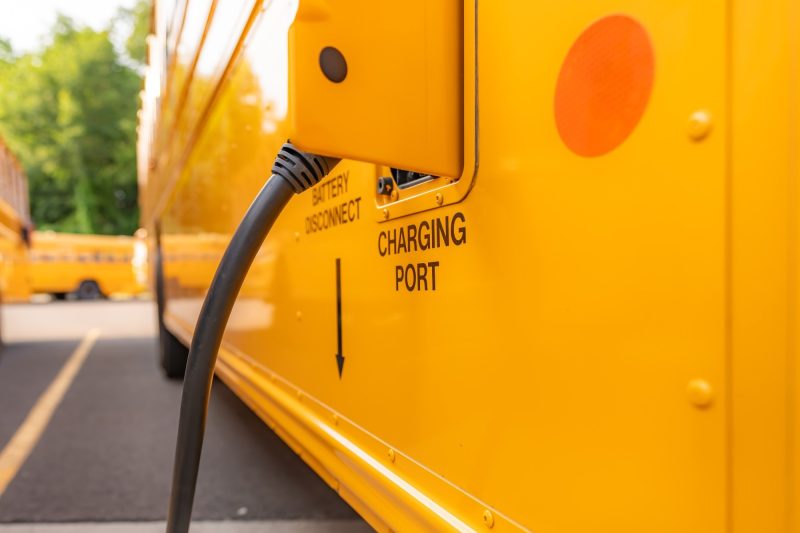Huge health and climate benefits of replacing old diesel school buses with electric in the United States

In a recent study published in PNAS, researchers assess the health and climate benefits of replacing old diesel school buses with electric buses in the United States.
Study: Adopting electric school buses in the United States: Health and climate benefits. Image Credit: SEALANDSKYPHOTO / Shutterstock.com
The environmental impact of diesel buses
The transportation sector is the most significant contributor to greenhouse gas (GHG) emissions and subsequent air pollution in the U.S. According to recent estimations, vehicle emissions are associated with around 20,000 deaths every year in the U.S., with 90% of these deaths caused by exposure to ambient fine particulate matter of 2.5 microns (PM2.5).
In the U.S., about 500,000 school buses serve about 24 million students. A significant proportion of these buses are model year (MY) 2005 diesel vehicles, which are estimated to emit 12 times more PM2.5 for every mile driven than model year 2010 diesel school buses.
Electric vehicles are considered a promising alternative to diesel vehicles in terms of reducing transportation’s health and environmental impacts globally. According to one 2023 estimate, 2,277 electric school buses are currently in circulation in the U.S., which account for only 0.5% of the nationwide school bus fleet.
Studies analyzing vehicle, fuel, maintenance, and insurance costs have suggested that the total cost of purchasing electric buses is about $156,000 USD higher than that for diesel buses in the absence of any subsidies. Given these high expenses, it is vital to assess the health and environmental benefits of electric vehicles to inform policy decisions regarding replacing old diesel school buses with electric buses.
About the study
In the current study, scientists estimate the per-mile benefits of replacing diesel school buses with electric buses in 3,108 U.S. counties.
Four types of replacements were considered, including the fleet average in 2017 for each county and diesel buses of MYs 2005, 2010, and 2020. The health benefits of electric school buses were determined by estimating mortality among adults and new asthma cases among children and adolescents due to chronic exposure to ambient PM2.5.
Important observations
Considering the average diesel school bus fleet in 2017, replacing it with an electric bus is estimated to provide health and climate benefits of $43,800 and $40,400 USD, respectively, due to the reduced emission of GHGs. The health benefits were associated with a reduction in PM2.5-attributable mortality and new childhood asthma cases, with economic values of $40,000 USD and $3,700 USD, respectively.
The entire diesel school bus fleet in 2017 was associated with 170 deaths and 280 new childhood asthma cases due to PM2.5 exposure. Comparatively, the researchers estimate that the complete replacement of diesel buses with electric buses would result in seven deaths and 12 new childhood asthma cases due to PM2.5 exposure.
 (A) Health benefits of school bus electrification when replacing the average diesel bus in the fleet in 2017, by driving location and outcome. (B) Health impacts of the school bus fleet in 2017 by driving location and pollutant species. Locations are classified using NCHS’s Urban–Rural classifications. DSB: Diesel School Bus. ESB: Electric School Bus.
(A) Health benefits of school bus electrification when replacing the average diesel bus in the fleet in 2017, by driving location and outcome. (B) Health impacts of the school bus fleet in 2017 by driving location and pollutant species. Locations are classified using NCHS’s Urban–Rural classifications. DSB: Diesel School Bus. ESB: Electric School Bus.
The health benefits of electric buses varied greatly depending on the MY of replaced diesel buses and the location of driving. A greater health benefit was observed by replacing diesel buses in more densely populated areas. The analysis combining counties by degree of urbanization revealed that the health benefits of electric buses vary from $85,800 USD in large central metropolitan counties to $16,800 USD in rural counties.
Considering vehicle MY, replacing MY 2005 diesel buses with electric buses is associated with seven times greater health benefits than replacing MY 2010 diesel buses and 16- to 18 times greater health benefits than replacing MY 2020 diesel buses. Furthermore, the health benefits of $207,200 USD can be achieved by replacing MY 2005 diesel miles driven in large central metropolitan areas.

Health benefits of electric school bus adoption in each county if they replace the average diesel school bus in each county’s fleet in 2017. Values smaller than $10,000 are not shown (n = 448 counties), including three counties with negative benefits varying between -$300 and -$800. County geographical boundaries are from the U.S. Census Bureau.
Study significance
The replacement of older diesel school buses with electric buses, particularly in densely populated areas, is projected to confer significant health benefits in terms of reduced mortality and new childhood asthma cases related to ambient PM2.5 exposure. However, replacing newer diesel buses with electric buses in areas with lower population density may produce more minor health benefits.
An electric school bus costs $156,000 USD more than a new diesel school bus over its lifetime. Nevertheless, the health benefits of electric buses are associated with an economic value of more than $200,000 USD per bus, thus demonstrating the cost-effectiveness of replacing diesel school buses with electric school buses.
The current study did not assess how electric buses might reduce children’s exposure to in-cabin air pollution while riding buses. The assessment of this additional health benefit is particularly important for policy decisions related to the deployment of electric school buses in rural areas, where health benefits associated with ambient PM2.5 exposure are insufficient to make such deployment cost-effective.








